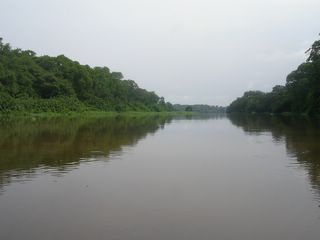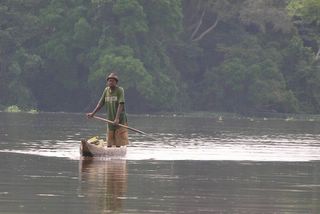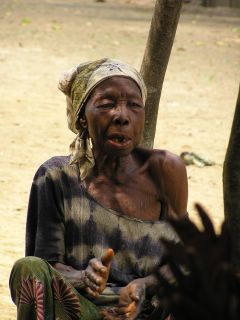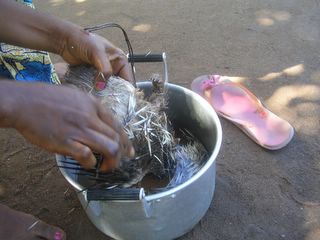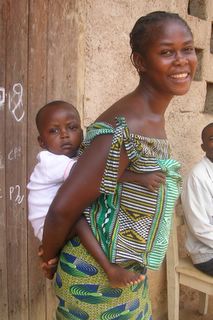Cross-cultural living never ceases to amaze. There’s so much that is new or different. What’s really fun, though, is when you come across something that is the exact opposite of your own culture. It really throws you for a loop. What is real? What is true?
Example: what do you do with a sick person?
At home it’s obvious, it’s common sense, that you don’t go to visit someone who is sick, with the exceptions of things like being laid up with a broken leg or having a surgery in the hospital. And even for those exceptions, only close family members and a few friends would dare to make an appearance. Our thinking is that a sick person needs lots of rest, shouldn’t be over-stimulated, could spread sickness to others, etc. Here, the idea of leaving a sick person alone is a horror. I’m not sure what all their thinking is, but it’s like if you leave the person alone with their sickness, the sickness will take over. If you let a lot of people come see the person they can all give advice for what to do until someone’s advice is what does the trick and the person gets better. Sick people lay on a mat in the living room and all the neighbors, friends, family, etc. come through all day to greet them or sit with them for a while. I’ve heard that westerners who get used to this find it very lonely to be sick back at home.
"The other promise of anthropology, one less fully distinguished and attended to than the first, has been to serve as a form of cultural critique for ourselves. In using portraits of other cultural patterns to reflect self-critically on our own ways, anthropology disrupts common sense and makes us reexamine our taken-for-granted assumptions." (http://en.wikipedia.org/wiki/Cultural_relativism)
Monday, July 31, 2006
Saturday, July 22, 2006

I went with my teammates Byron and Annette. It was sort of an experiment in transportation and visiting villages. We will be better equipped now to plan our research in the future. It's fun getting to know the country better and it seems to help me in every thing I do. Even back in the big city of Brazza, just having that knowledge of some of the rest of the country informs my interactions with people.

From one village we hiked into the forest to a neighboring village just a few minutes away. The "villages" are basically just clearings in the woods. We hiked down another trail just to see some of the forest. There were these posts every so often and we were told they were marking out territory that the president's daughter chose for her tourist resort she wants to build. Like that will ever happen. She's married to a man from Morocco, so they referred to her as the "Moroccan Princess."
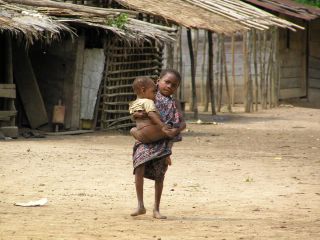
I love this photo. Wish I'd been the one to take it, but this came from Byron. They told us we could take pictures, but I was still a little hesitant to do so. It is very typical to see kids taking care of younger kids. Works out great for the parents! And by the time they have their own babies they know all about taking care of them. Unlike our society where people my age have grandma do the work 'cause they don't have a clue :o)
Monday, July 17, 2006
Congolese Cuisine
Well, of course one of the most interesting things about travel is the food. Here's a blog entry with photos all dedicated to my eating experiences in Northern Congo. My friends know it's one of my favorite subjects :o) I have weeded out a lot of the pictures for the sake of my vegetarian sister. I love you Cathie Jo!
The grossest food I saw people preparing was antelope head. The grossest thing I tasted was probably porcupine. The best new experience was eating elephant! It had been dried and then can be prepared like beef. It was really good! Supposedly the animal is so big that after they kill it the hunters basically go inside it to cut out the different parts.
I found out that the Congolese are basically hunter-gatherers. Fishing and some cultivation (manioc, peanuts, fruit, and sugar cane) are also important.
Despite signs posted around saying not to touch monkeys, people still eat them and have them as pets. Supposedly the hunters are being careful about ebola virus by not killing any sick monkeys or picking up ones that were already dead. We refrained from touching/eating/whatever. Just say no to ebola.
During our time in Ouesso we usually ate lunch in one of two restaurants. To make sure there would be something edible for us, we'd place an order the day before or in the morning. We often just ate rice and beans, which was tasty and satisfying. But we could order anything available in town, including wild boar, antelope, and beef. In the evening we'd eat something simple at home. Simple usually meant semi gross and unhealthy. Bread with Vache Qui Rit ("Laughing Cow," a spreadable "cheese." The cow is laughing that we actually ate it), beignets (doughnut balls fried every morning and night by women all around town), pasta noodles with onion and garlic (that was actually good). That was about it. Oh, towards the end we discovered a woman who grills chicken legs every night. It's super good! We can't figure it out though because there's a ban on imported chicken right now, but hers was so tender there's no way it was local.
All that to say that by the time we got back to Brazzaville my mouth was watering for some American food!
The grossest food I saw people preparing was antelope head. The grossest thing I tasted was probably porcupine. The best new experience was eating elephant! It had been dried and then can be prepared like beef. It was really good! Supposedly the animal is so big that after they kill it the hunters basically go inside it to cut out the different parts.
I found out that the Congolese are basically hunter-gatherers. Fishing and some cultivation (manioc, peanuts, fruit, and sugar cane) are also important.
Despite signs posted around saying not to touch monkeys, people still eat them and have them as pets. Supposedly the hunters are being careful about ebola virus by not killing any sick monkeys or picking up ones that were already dead. We refrained from touching/eating/whatever. Just say no to ebola.
During our time in Ouesso we usually ate lunch in one of two restaurants. To make sure there would be something edible for us, we'd place an order the day before or in the morning. We often just ate rice and beans, which was tasty and satisfying. But we could order anything available in town, including wild boar, antelope, and beef. In the evening we'd eat something simple at home. Simple usually meant semi gross and unhealthy. Bread with Vache Qui Rit ("Laughing Cow," a spreadable "cheese." The cow is laughing that we actually ate it), beignets (doughnut balls fried every morning and night by women all around town), pasta noodles with onion and garlic (that was actually good). That was about it. Oh, towards the end we discovered a woman who grills chicken legs every night. It's super good! We can't figure it out though because there's a ban on imported chicken right now, but hers was so tender there's no way it was local.
All that to say that by the time we got back to Brazzaville my mouth was watering for some American food!
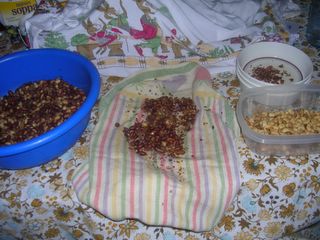
Someone gave us a big bag of peanuts, a common crop here. So we had the brilliant idea of making our own peanut butter. First they had to be cleaned. Then roasted over a coal fire. Then the skins had to be removed. Finally they were ready to be taken to the lady with the grinder. It cost just a little for the coal and the grinding, but we called it our $40 PB after we calculated the man-hours it took to make! I have a new appreciation for JIF :o) Later we decided to just buy it at the market from the ladies who sell it out of big bowls. You get a pretty good sized lump for $1 and they wrap it in a banana leaf.

Everyone kept giving us sugar cane from their fields. It usually ending up going bad before we'd eat it. It's so much work! You gotta get off the outside (which requires a knife, unless you're an African and you've been getting it off with your teeth since you were 5) and then you just gnaw on the inside. It is nice and sweet, but we're not particularly into it.
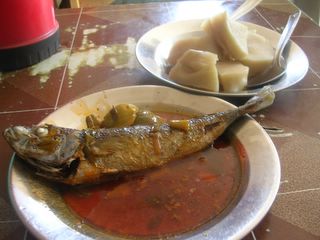
Here's a VERY typical Congolese meal: fish (sitting in lots of palm oil, which is actually kind of tasty with a little tomato sauce and veggies cooked in it) and kwanga/manioc (a plant that takes a ton of work to prepare and yields a not very exciting result in my opinion, but it's the staple here). "Give us today our daily kwanga..."

This was a really special meal. These bowls are full of Kwanga (manioc--to be explained pictorally at a later date), rice, chicken with palm oil and potatoes, plain chicken, and sakasaka (uh, I think it's some kind of leaf cooked and put with oil and salted fish, not bad overall). We had amazing papaya and pineapple for dessert.
Friday, July 14, 2006
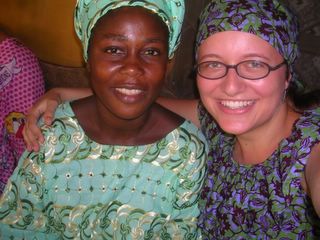
This is me and my Lingala language helper Lili at our going away celebration last week. I never knew I was so white! After 5 weeks of working together, she was very sorry to see me go. But I will be going back to Ouesso again in August so for now I'm just glad to be back in the city eating hamburgers, drinking cold water, taking hot showers, and enjoying the cool dry season.
B-b-b-back to Brazza!
Hi friends. It's been a long blogging pause. Did you know that there are places in the world that still don't have Internet? Well, I found one of those places and stayed there for 5 weeks. But I just consider that I was gathering wood for the blogging fire. Now I have stories and pictures that are sure to please. I've posted a few pics below just to give you a taste, but never fear, there is much more to come. Think "antelope head" and "pygmies" and "parasites." Oh yes, the stories will make you laugh and the photos will capture your hearts. OK, that's enough publicity for now. Enjoy!

This was one of our first language sessions. We had one language helper assigned to us, but often the yard would fill up with kids or else some random man would come and try to take over the lesson, as in this photo. By the end, though, people were used to us so we usually got some quality time without interruption. And our language helper was faithful and patient right to the end. We really praised God for her.
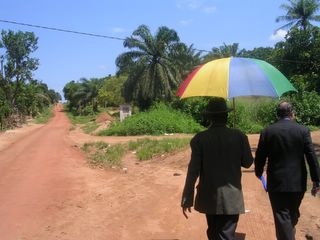
"Ouesso" means "sun" in one of the local langauges. It certainly lived up to its reputation! Very hot and sunny and just 1.3 degrees north of the equator! I enjoyed seeing the Africans using parasols. This is Byron and Pastor Akoula after we'd gone to visit the mayor and regional governor's offices. Imagine wearing a suit in this climate! I like all the red dirt roads and greenery.

The World cup factored big into our time in Ouesso. The mayor provided a big screen television for people to watch it on...in the field right outside our house! So from about 3-10pm every day we got to listen to the sports announcers and the cheers of the crowd. That's our house to the left of the photo. Those two disks you see above the trees are some kind of really tall radio tower.

One of the cool surprises of our trip was for the first week there was a Swedish missionary staying with us in the house who had worked in Ouesso years and years ago (he's the white haired man on the right). It was his first visit after like 40 years. Many of the church leaders we met in Ouesso had been trained by that man, so they really honored him. We felt like we got to be part of a historic moment.
Subscribe to:
Posts (Atom)
